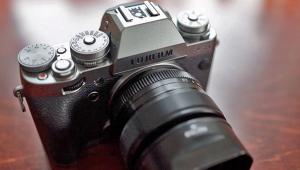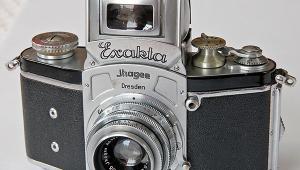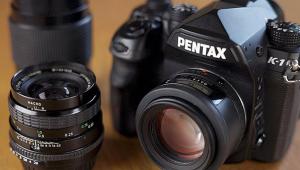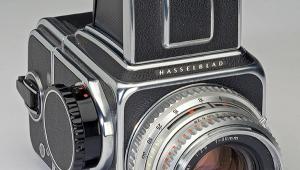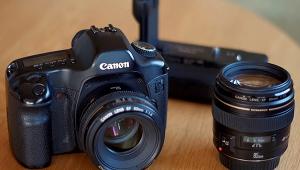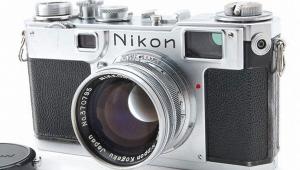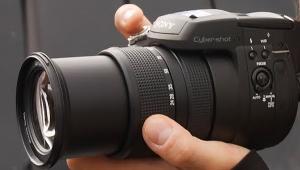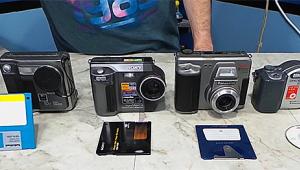Contessa Nettel Deckrullo 6x9cm: A “Doppel-Klapp” Design
It’s a dream specification. Top-flight construction; about the same weight and bulk as a professional D-SLR, though rather more convenient in shape; interchangeable lenses; camera movements; choice of ground-glass or viewfinder viewing; and a great big juicy 6x9cm format. It’s finished in beautiful Morocco-grain leather and the controls and fittings are in nickel and black-lacquered brass. It certainly sounds both desirable and usable.

All Photos © Roger Hicks Ltd.


Which all goes to show that you shouldn’t judge a camera by specifications alone, at least unless you know when it was made; which is a bit of a question in itself. Contessa Nettel was formed in 1919 by the amalgamation of Contessa Camerawerk Drexler and the Nagel and Nettel Camerawerk, so it’s after that, but the Contessa Nettel name continued to be used after the amalgamation with Zeiss in 1926. The same basic cameras were made in a range of formats from 6x4.5cm to 13x18cm (near enough 5x7”) until the late 1930s, so as a rough guide they are between 70 and 90 years old. This particular one probably dates from 1922, going by the serial number of the Zeiss Tessar lens.
It’s of a style known to collectors as a doppel-klapp: two blocks, the main body of the camera and the front standard, linked together by X-shaped struts top and bottom. Further V-shaped struts, top and bottom, transfer the focus movement so both sets of X-struts are adjusted simultaneously.
The actual focusing movement is via a multi-start lead screw, driven by a knurled knob on the top front of the right-hand side of the main body; the pictures show the camera with the focusing scale removed, so you can see both the lead screw and what appears to be a broken bar linked to it.
Well, it isn’t broken, and it’s the one thing about a Contessa Nettel Deckrullo that is not immediately obvious even to the reasonably experienced camera collector. The two parts are latched together, and you need to unlatch them in order to collapse the camera. Here is the unexpected part: the latch is the index stud for the distance scale. Push down on this; the bar separates; and you can close the camera. By the look and feel of it, at least one previous owner did not know this, so the latch isn’t as tight as it might be. Because of this and the stiffness of the elderly bellows, the bar tends to self-unlatch at a bit below 2 meters on the distance scale for the standard 12cm (120mm) f/4.5 Zeiss Tessar, though from there to infinity (and beyond) everything still operates perfectly.
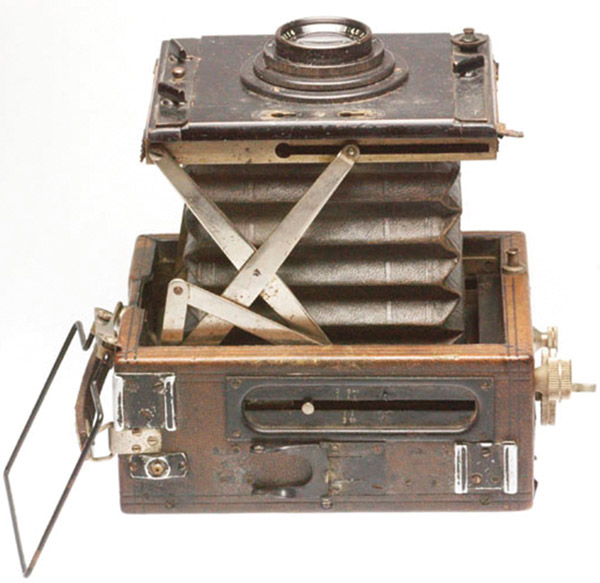

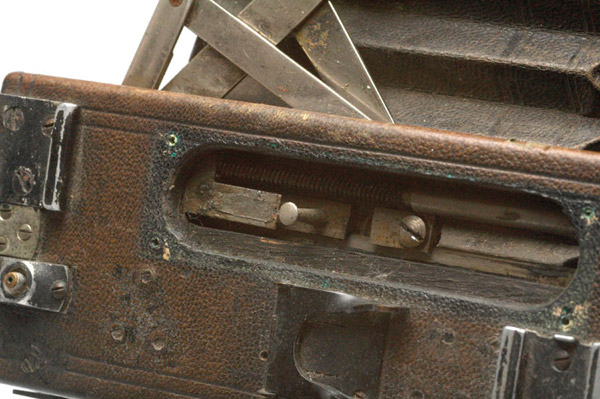
The really ingenious thing about such a focusing mechanism is that it can be set up for infinity focus for a wide range of lenses from about 75mm to about 135mm, though with anything longer than about 5” (127mm) your scope for close focusing is going to be pretty limited. All you need is multiple focusing scales. Set the distance on the appropriate scale; pull out the front standard; and it will click into place, focused and ready to shoot.
Likewise, the simple wire-frame viewfinder automatically adjusts for the field of view. Longer lenses; front standard further away; narrower angle of view. Wide angles; front standard nearer; etc. An interesting touch is that the rear sight is not actually a peep sight, but consists of two uprights, each pierced with a hole. Line up both holes: your eye is centered. Cunning, eh? The front frame is quickly detachable, so you can switch it from one panel to another.
The vast majority of 6x9cm Deckrullos had 12cm Tessars. Mine is no exception. The (uncoated) lens is marked in the old Continental scale of f/4.5, f/6.3, f/9, f/12, f/18, f/24, f/36. The engraved numbers are tiny, and although they may once have been filled with white paint, this is long gone and they are very hard to read. The aperture index mark does double duty as one of two notches for applying a spanner to remove the front cell of the lens.


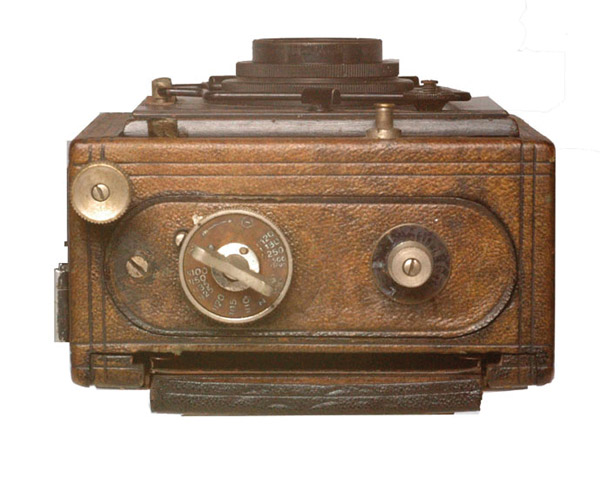
The lens is mounted on a panel, which is retained by slipping it under a bar on one side, then sliding another bar across the other side. There are three locking screws, two on the sliding bar side and one on the slip-under fixed bar side. All have transverse finger-grip heads, and when they are slacked off, they allow the lens panel to be moved up and down a tiny amount, a total movement of about 14mm or just over half an inch. Clever design means you can do this without any risk of releasing the retaining bar.
Another locking screw, with a big knurled head, allows the panel to slide left and right, or indeed to fall out completely, as I found when I was writing this. The movement here is much greater, well over 20mm each way (just short of an inch) for a total of 46mm or so. This makes sense, as the long axis is where you would normally want the rising front. To this end, there are two tripod sockets (standard 3⁄8” instead of the now-common 1⁄4”), one on the bottom and one on the opposite face from the shutter controls. The elegant thing here is that the hand strap, which would otherwise foul the socket, is permanently secured at the top end but has a spring-loaded quick release at the bottom end, so it can be folded out of the way.
To return to the lens and focusing on mine, there is only one very primitive focusing scale for the 12cm, stamped and paint-filled. It is marked both above and below the slot: infinity (above), 10 meters (below), 5 meters (above), 3 meters (below), and 2 meters (above). I have seen others with far more elegant and precise scales, often engraved, for two or even three lenses. Then again, these have normally been the “Tropen” or tropical models, with polished teak bodies (instead of leather-covered mahogany) and much more nickel plating in place of lacquered brass. I think that the focusing scale on mine is original: it’s just a bottom-of-the-line model.

The fact that the camera has been neatly flash synchronized, as well as having two accessory shoes, argues that it may have been used as a press camera. Normally 6x9cm would have been regarded as laughably small for such a purpose, but equally, this may have been a cheap, knockabout camera that was bought because one reporter was a devotee of miniature formats, or flash, or some such other fad. No point in buying the deluxe model if that was the case!
There is however nothing “bottom of the line” about the big, self-capping focal-plane shutter which gave the camera its name: deck from the German for “cover” or “covering,” e.g., self-capping, and rullo from the French rouleau or roll: focal-plane shutters of this type are also known as roller-blind shutters. Most earlier focal-plane shutters were not self-capping, so you had to use a lens cap or insert a dark slide when winding the shutter or you would expose the film (or more likely, plate).
Two separate speed scales are engraved around the shutter winding knob, which also has a big nickel folding key, and an engraved arrow to tell you which way to turn it. The first series is 1⁄120, 1⁄180, 1⁄250, 1⁄500, 1⁄1200; the second, 1⁄10, 1⁄15, 1⁄25, 1⁄35, 1⁄50, and 1⁄100. To set the speeds, you push the collar around the wind-on downward and set a choice of two index marks against the desired speed. There is also a “Z” (Zeit, Time) engraving, for focusing on the ground glass and for anything longer than 1⁄10 sec: first pressure opens the shutter, second pressure closes it.
As you might guess, this is the classic press camera-type shutter with variable slit width and variable tension. High tension gives you Range 1; the much more leisurely low tension, Range 2. A second knob, directly below the first, has three positions, marked (barely legibly after all this time) Z, 2, 1; it is also engraved “Contessa Nettel.” Amazingly, almost everything still seems to work, apart from an intermittent tendency to grind to a halt when trying to close from Z. Cleaning and lubricating the shutter—possibly even replacing the baggy, elderly blinds, instructions for which can be found on the Internet—would almost certainly restore it to full working order.
At which point, why don’t I do this, and use the camera? Well, there are at least six reasons. One is that I’m just not as much into restoring elderly cameras as I used to be. The second (closely related to the first) is that if I’m going to take pictures, I’d rather use a modern, versatile camera such as my Alpa or “baby” Linhof. The third is that scale focusing a 120mm f/4.5 lens at full aperture is something you need to practice, though with two accessory shoes, it would be easy enough to carry an accessory rangefinder.
A fourth is that I don’t have a rollfilm back for it, or even plate holders. By the 1920s these were semi-standardized, but only semi, so I’d need to haunt the camera fairs and try a range of holders in order to find one that worked; and besides, they don’t hold the film very flat. The normal multi-shot magazine for a Deckrullo held 12 glass plates, so flatness wasn’t a concern, but weight was; and today, in any case, there are very few plate sizes available.
The fifth is that, heretically, I’ve never been an admirer of Tessars faster than f/6.3. The f/6.3 is stunning; f/4.5 is so-so; and f/3.5 is just about OK for portraits. And the sixth is that frankly, the shutter speed and aperture scales are so hard to see that I’d need to do a fair degree of restoration there, too.
In other words, it was a great camera when it was made, rather more than 80 years ago, but it’s also a good illustration of how far camera design has advanced in the meanwhile.
What’s it worth? Prices are all over the place. I probably paid about right for mine, or a little over the odds, at about $120. That’s given the state it’s in. If I cleaned it up, and found a rollfilm back, I might be able to get twice that for it: I’ve seen similar cameras for sale at $300+. For under $100, you’re probably looking at incomplete (no ground-glass back or film holders), or nonfunctioning, or both. At the other extreme, a teak-and-nickel tropical model, complete, in perfect order, could easily top $2000, especially if it had a wide-angle lens as well.
For further information on the art and craft of photography from Roger Hicks and Frances Schultz, go to www.rogerandfrances.com.
